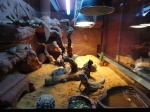Danniy
Contributeur Régulier au Savoir Respecté

Nombre de messages : 143
 Age : 44 Age : 44
Localisation : Floriffoux - Belgique
Emploi : chimiste
Loisirs/Humeur : Whisky - Rhum - Vin, toujours partante pour un petit verre
Date d'inscription : 26/08/2012
 |  Sujet: articles scientifiques Sujet: articles scientifiques  Mar 30 Oct 2012, 14:19 Mar 30 Oct 2012, 14:19 | |
| Bonjour,
Grâce à mon boulot, j'ai accès à certains articles scientifiques, je ne peux les mettre directement sur le forum pour des raisons évidentes de copyright, mais si cela vous intéresse contactez moi par MP.
En voici quelques uns que j'ai déjà concernant les pogonas vitticeps:
Article 1
"Effects of vitamin D3 supplementation and UVb exposure on the growth and plasma concentration of vitamin D3 metabolites in juvenile bearded dragons
(Pogona vitticeps)"
D.G.A.B. Oonincx, Y. Stevens a, J.J.G.C. van den Borne, J.P.T.M. van Leeuwen, W.H. Hendriks
The effectiveness of dietary vitamin D3 and UVb exposure on plasma vitamin D metabolites in growing bearded
dragons (Pogona vitticeps) was studied. A total of 84 (40 males and 44 females) newly hatched bearded dragons
were allocated to six levels of oral vitamin D3 supplementation (0 to 400%) or six UVb exposure times (2 to 12 h).
At 3 and 6 months of age, blood samples were obtained from each animal and analysed for 25(OH)D3 and 1,25
(OH)2D3. At 3 months of age, plasma concentrations of 25(OH)D3 did not increase with increasing vitamin D3
supplementation unlike the 1,25(OH)2D3. At 6 months of age, plasma concentrations of both 25(OH)D3 and 1,25
(OH)2D3 increased with increasing vitamin D3 supplementation. Plasma concentrations in UVb-exposed animals
were 18 times higher for 25(OH)D3 (178.4±9.0 vs. 9.9±1.3 nmol/L) and 5.3 times higher for 1,25(OH)2D3
(1.205±0.100 vs. 0.229±0.025 nmol/L) than in vitamin D3 supplemented animals at 6 months of age. This study
shows that 2 h of UVb exposure enables adequate physiological concentrations of plasma vitamin D metabolites
to bemaintained in growing bearded dragons. Oral supplementation of vitaminD3 is ineffective in raising plasma
concentrations of 25(OH)D3 and 1,25(OH)2D3 to concentrations observed in UVb-exposed animals.
Article 2
"Two Common Disorders of Captive Bearded Dragons (Pogona vitticeps): Nutritional Secondary Hyperparathyroidism and Constipation"
Kevin Wright, DVM
Abstract
Two common disorders of captive bearded dragons are nutritional secondary hyperparathyroidism
(NSHP) and constipation. Recognizing the husbandry factors that predispose
bearded dragons to these disease conditions is an important clinical skill. Treatment of
NSHP is aimed at correcting husbandry deficiencies and dietary management. Treatment
of constipation depends on the underlying cause but is frequently due to a lack of sufficient
water in the diet and the environment.
Articel 3
"Bearded dragons (Pogona vitticeps) asymptomatically infected with Devriesea agamarum are a source of persistent clinical infection in captive colonies of dab lizards (Uromastyx sp.)"
R. Devloo *, A. Martel, T. Hellebuyck, K. Vranckx, F. Haesebrouck, F. Pasmans
Devriesea agamarum causes dermatitis and septicaemia in a variety of lizards, notably
those belonging to the genus Uromastyx, whereas other species such as bearded dragons
(Pogona vitticeps) seem to be asymptomatic carriers. Using amplified fragment length
polymorphism (AFLP), the relatedness between 69 D. agamarum isolates was examined.
The isolates derived from 44 diseased lizards, of which 31 belonged to the genus
Uromastyx, and from 25 healthy lizards, of which 21 were bearded dragons. Eight AFLP
genotypes were obtained, four of which comprised 93% of the isolates. These four
genotypes were each present in 2, 2, 8 and 13 different captive colonies. Up to three
genotypes were isolated from a single infected colony simultaneously. On two occasions,
the same genotype was found in healthy bearded dragons and diseased Uromastyx lizards
from the same colony, confirming the role of the former as an asymptomatic source of
infection for the latter. Two genotypes, comprising 12 isolates, were exclusively associated
with diseased Uromastyx lizards, suggesting strain dependent host adaptation. Finally, D.
agamarum was shown to be able to persist for at least seven years in a lizard colony,
persistently causing severe disease in several lizard species.
Article 4
"Evaluating Quikon® Med as a Coccidiocide for Inland Bearded Dragons (Pogona vitticeps)"
C. Brad Singleton, BS,
Mark Mitchell, DVM, MS, PhD,
Shannon Riggs, DVM,
Orlando Diaz, DVM, MS
Isospora amphiboluri is the most common coccidian isolated from captive bearded dragons.
This parasite can cause severe, debilitating disease in juvenile dragons. Most treatment
recommendations for I amphiboluri are anecdotal and based on the administration of
coccidiostatic compounds. Essential oil extracted from oregano (Origanum vulgare) has
been successfully used as a coccidiocide in poultry and may prove efficacious for reptiles.
The purpose of this study was to evaluate the efficacy of a commercial herbal product
(Quikon® Med) against I amphiboluri in juvenile bearded dragons. Twenty-four juvenile
bearded dragons were included in this study and divided into 3 study groups. Group 1
received 6-g Quikon® Med/1-L 0.9% saline solution during the first treatment and 24 g/L
during the second treatment. Group 2 received 3 g/L during the first treatment and 48 g/L
during the second treatment. Group 3 served as the control during both treatment periods
and received only 0.9% saline solution. The treatments were all dosed at 10 mL/kg/d to
simulate maintenance fluid intake. Because all of the dragons remained positive after using
the first treatment concentration of the commercial product, a second treatment interval
was initiated, increasing the Quikon® Med dose. Dragons treated with Quikon® Med had
significantly (P<.05) higher body weights than the control dragons at the end of the study;
however, the treatment had no effect on the coccidia status of the dragons
|
|
__NiCo__
Jeune et fougueux Caméléon décrépit (Consultant).

Nombre de messages : 2285
 Age : 29 Age : 29
Localisation : Jura
Date d'inscription : 11/10/2009
 |  Sujet: Re: articles scientifiques Sujet: Re: articles scientifiques  Mar 30 Oct 2012, 14:49 Mar 30 Oct 2012, 14:49 | |
| Mp !  |
|







